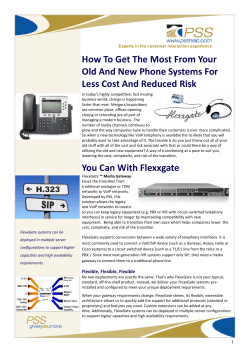
Four Steps to IVR Application Excellence
2015 Annual Speech Reference Guide Sponsored Content TECHNOLOGY Four Steps to IVR Application Excellence Step 1: Simplify IVR Application Creation and Migration Welcome to Convergys’ white paper series, Four Steps to IVR Application Excellence, designed to help you streamline your internal application development process while preserving the effortless experience your customers expect. We will begin this series with design and development best practices, then explore the end-user experience, followed by a look at optimization and tuning. We’ll end the series with tips on how to use reporting and analytics to ensure ongoing success. Accelerating Application Creation Most voice user interface (VUI) applications are documented using Visio, MS Word, or a combination of the two. And, while documenting an IVR call flow may appear simple, it is often quite complex. A labyrinth of menu paths, alternate prompting, and varying data conditions ultimately produces a large design document that is challenging to manage—not only during the initial implementation, but also throughout post-production updates and changes. Here’s a common scenario: It’s time for the next big quarterly release of your VUI application. Your business line is adding multiple new menus and conditions to your existing handling to take callers to these new menus. You’re dreading the updates because once you finish the high-level call flow, you must provide detailed design specifications to the developers. Then, once the detailed specifications are approved, you have to find your old prompt list from last quarter and manually add the new prompts and edit old ones for the new release. That’s a lot of copying and pasting! The good news is there is a better way. www.speechtechmag.com Innovative design tools allow you to specify the design once, then click one button to generate a high level call flow, another button to generate the detailed design document, and a third one to create the prompt recording list. Today’s advanced tools also smartly enable the generation of test cases, and, in some cases, the generation of code for the user interface portions of the application, saving hundreds of hours on typical projects. documentation. Because the code is not being written from scratch again, development and testing time can be significantly reduced, compared to a full life-cycle development effort. The generated code can be edited as needed, and can often be greatly improved upon by moving appropriate logic that was originally written in the legacy application into standard languages such as Java or JavaScript. Dealing with End-of-Life Migrations Summary Let’s look at another common situation that strikes fear in the heart of IT and business application owners alike: Your company has a large IVR selfservice application that is crucial to your contact center and your customers. It takes 99% of all the traffic coming into your 800 numbers and provides a solid containment rate that would be extremely expensive if disrupted. Using the right tools for new application builds, ongoing maintenance or legacy application migration takes the pain out of design maintenance and system migration. You helped build this application to what it is today and remember when it first launched over a decade ago. So, when you hear “End of Life”, you think, “Nobody really understands how big this application is.” You realize your documentation is in Visio format, and it hasn’t been updated in five years. How can someone rebuild your application if the only documentation that matches your existing code is your existing code? To solve this dilemma, you need a robust translator tool that can read your existing application, library, translator table, and business hours source code and convert them, form-by-form, into code that is compatible with the new platform. By starting with the currently-in-production legacy code, you can be assured all your latest application logic is included and eliminate the need to rely on out-of-date To learn more about Convergys’ application design and translation tools, visit www.convergys.com/IVR and make plans to attend our informative webinar on February 18, 2015. Also, stay tuned for Step 2: Design Your IVR Around the Customer Journey in the Summer 2015 issue of this magazine. Why Convergys: Convergys is the only contact center solution provider with more than 30 years of hands-on customer care success. We don’t just sell solutions, we use them ourselves, along with our best practices and analytics. And we take that knowledge and experience and use it to constantly improve our solutions. Because we gain a great deal of insight from handling more than 5 billion customer interactions every year, we are experts in not just contact center technology, but in what it takes to help you deploy and use that technology to meet your unique business goals. Speech Technology 2015 Reference Guide RG19
© Copyright 2025












![Chapter 3 Homework Review Questions Lesson 3.1 [pp. 78 85]](http://cdn1.abcdocz.com/store/data/000248451_1-668327adcad67c478c93f46227ffd100-250x500.png)